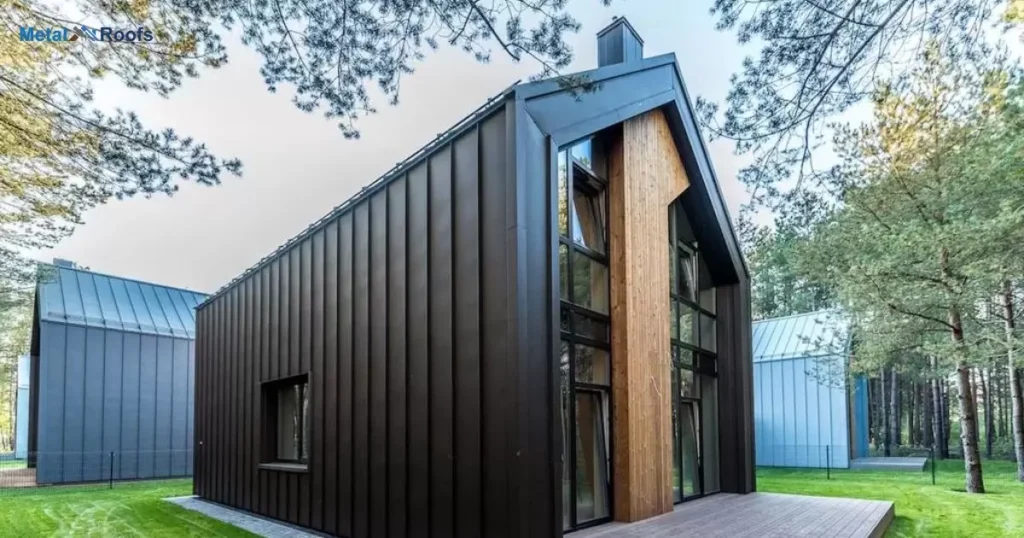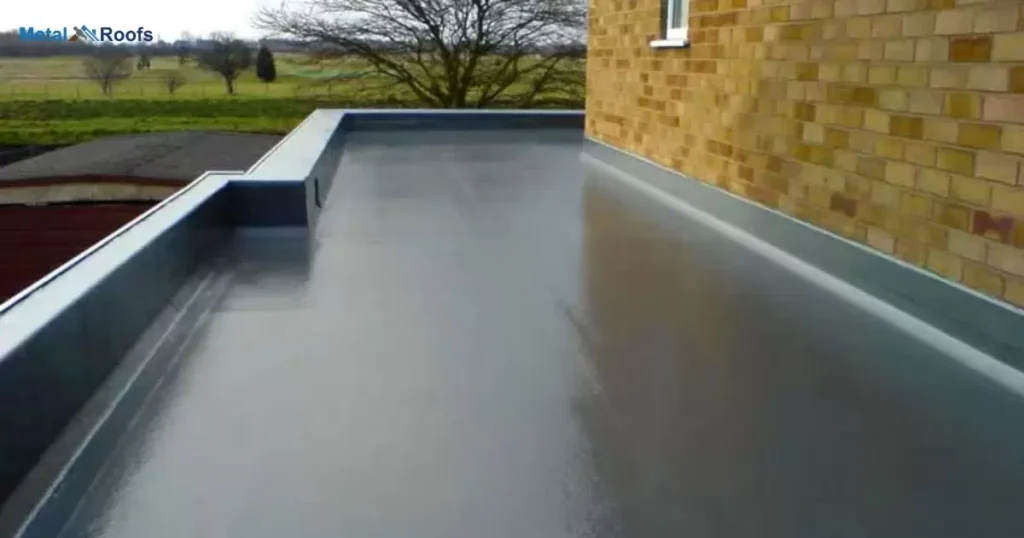A metal roof’s slope is its angle from top to bottom. Steeper slopes shed water better. Lower slopes cost less. Most metal roofs need at least a 3/12 pitch. This means 3 inches of rise for every 12 inches of length. Check local codes for the right slope.
Metal roofs need proper drainage. Too flat, and water pools. This causes leaks and damage. So, what is minimum slope for metal roof? It depends on the type. But generally, it’s steeper than other roofs. This ensures water flows off quickly.
Different metal roofs have different slope needs. Standing seam roofs can be flatter. Corrugated ones need more pitch. Your choice affects water flow, making it crucial to consider when deciding which color metal roof is best for your needs.
Key Takeaways
- Metal roofs require a minimum slope for proper drainage.
- Standing seam roofs typically need a 1/4:12 slope.
- Corrugated metal roofs also need at least a 1/4:12 slope.
- Manufacturer guidelines should be followed for specific requirements.
- Local building codes may dictate minimum slope regulations.
Pitched Roof Calculator
A pitched roof calculator helps determine the slope of your roof. You input the dimensions of your roof and the calculator computes the pitch. It’s handy for planning roofing projects or understanding your existing roof better.
By knowing the pitch, you can choose appropriate roofing materials and ensure proper drainage. This helps prevent water damage and prolongs the lifespan of your roof. With a pitched roof calculator, you can make informed decisions about your roofing needs.
Minimum Pitch Metal Roof
| Roof Material | Minimum Pitch |
| Steel Panels | 1:12 |
| Aluminum | 0.5:12 |
| Copper | 3:12 |
| Zinc | 1.5:12 |
| Galvanized | 1:12 |
Metal roofs require a minimum slope to ensure proper drainage of water. Standing seam roofs typically need a minimum slope of 1/4:12, meaning a quarter-inch rise for every twelve inches of horizontal run. The same principle applies to corrugated metal roofs.
It’s crucial to adhere to the guidelines provided by the manufacturer for installation to ensure optimal performance and longevity of the roof. Local building codes may specify minimum slope requirements for roofing materials, so it’s essential to verify these regulations before beginning the installation process.
Roof Pitch To Angle

The pitch of a roof determines its angle. For metal roofs, the pitch is crucial for proper drainage. Standing seam roofs usually need a 1/4:12 pitch. This means a rise of 1/4 inch for every 12 inches of horizontal run.
Similarly, corrugated metal roofs also need at least a 1/4:12 pitch. Following manufacturer guidelines ensures correct installation. Local building codes may also dictate minimum pitch requirements. Checking these regulations beforehand prevents complications later on.
Why Is Minimum Slope Important?
A minimum slope matters for metal roofs because it ensures proper drainage. Without it, water can pool, leading to leaks and structural damage. Standing seam metal roofs, for instance, need a slight incline to shed water efficiently.
Corrugated metal roofs also require a similar slope to prevent water buildup. Following manufacturer guidelines is vital as they specify the best slope for each type of metal roofing. Local building codes often mandate minimum slopes to maintain safety standards.
1/12 Pitch Roof
A 1/12 pitch roof is incredibly flat. It has a minimal incline, which means water doesn’t easily drain off it. Due to its low slope, it’s not suitable for all roofing materials. For instance, shingles might not perform well on such a flat surface. It could work for certain types of metal roofing.
Installation of a 1/12 pitch roof requires careful consideration. Without proper drainage, water pooling can occur, leading to leaks and structural issues. Therefore, it’s essential to consult with roofing experts to determine the best course of action.
Minimum Slope For Standing Seam Metal Roof

For standing seam metal roofs, a minimum slope is crucial. It ensures proper water drainage and prevents leaks. Typically, a 1/4:12 slope is required. This means a rise of 1/4 inch for every 12 inches of horizontal run.
This may vary based on manufacturer specifications and installation details. It’s essential to consult the manufacturer’s guidelines for specific requirements. Also, local building codes might have regulations regarding minimum slope for roofing materials. Checking these regulations is important before installation.
Minimum Slope For Metal Shed Roof
Metal shed roofs need a minimum slope for proper drainage. A 1/4:12 slope is typically required. This means a rise of 1/4 inch for every 12 inches of horizontal run. Corrugated metal roofs, common in sheds, also adhere to this slope requirement.
Manufacturers provide guidelines for specific materials. Always follow these guidelines for the best results.Check local building codes for any slope regulations. Keeping within these parameters ensures a durable and effective metal shed roof.
What Are The Benefits Of Proper Slope?
Proper slope, whether in landscaping, construction, or drainage systems, offers several benefits:
Effective Drainage: Slope ensures proper water runoff, preventing water accumulation that can lead to erosion, flooding, or water damage. It directs water away from structures, reducing the risk of foundation damage and basement flooding.
Prevents Soil Erosion: Slope helps prevent soil erosion by controlling the flow of water. Without proper slope, water can wash away topsoil, leading to barren patches, loss of nutrients, and destabilization of landscapes.
Enhanced Landscaping: Slope can be used strategically in landscaping to create visual interest, define different areas of a garden, or facilitate the growth of specific plants that require good drainage.
Improved Safety: Properly sloped surfaces, such as roads, sidewalks, and trails, enhance safety by reducing the risk of water pooling, ice formation, or slippery surfaces, which can cause accidents.
Structural Integrity: In construction, ensuring proper slope in foundations, floors, and roofs helps maintain structural integrity by preventing water damage, mold growth, and degradation of building materials.
Optimized Agricultural Practices: Slope is crucial in agriculture for managing irrigation, controlling soil erosion, and maximizing water use efficiency. Terracing, a technique that utilizes sloped land, helps create flat surfaces for cultivation on hilly terrain.
Flood Prevention: Properly designed slopes in flood-prone areas can help redirect water away from vulnerable areas, mitigating the risk of damage to properties and infrastructure during heavy rainfall or storms.
Cost Savings: By preventing water-related damage to structures, landscapes, and infrastructure, proper slope can lead to significant cost savings over time by reducing the need for repairs and maintenance.
Overall, proper slope management is essential for environmental sustainability, infrastructure resilience, and the safety and well-being of communities.
Minimum Slope For Roof Drainage

Metal roofs need a minimum slope for proper drainage. Standing seam roofs typically require a 1/4:12 slope. This means a quarter-inch rise for every 12 inches of horizontal run. Similarly, corrugated metal roofs also need at least a 1/4:12 slope. This helps water shed efficiently and prevents pooling.
It’s crucial to follow manufacturer guidelines for specific requirements. Local building codes may dictate minimum slope regulations. Always check these before installing a metal roof to ensure compliance and optimal performance.
Frequently Asked Questions
Can You Use Metal Roofing On A 1/12 Pitch Roof?
Yes, you can use standing seam metal roofing on a 1/12 pitch roof with proper installation techniques.
What Is The Slope Angle For A Metal Roof?
Metal roofs require a minimum slope for effective drainage, typically around 1/4:12.
Can You Put A Metal Roof On A Low Slope?
Yes, metal roofs can be installed on low slopes as long as proper guidelines are followed.
Conclusion
When considering a metal roof for your home, ensure it meets the required slope guidelines. Consult manufacturer specifications and local building codes for proper installation.
Following these guidelines prevents water pooling and ensures effective drainage. With the right slope and installation, a metal roof offers durable protection. Choose wisely to enjoy long-lasting performance and peace of mind.











